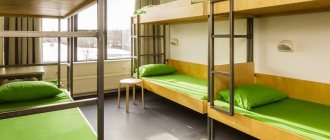The concept of “norm for the provision of living space”
The terms “norm for the provision of living space” and “accounting norm for the area of living space” are defined in Art. 50 Housing Code of the Russian Federation. The basis for this is the purpose implied by the use of the presented standards.
According to this, it is possible to derive a definition of what the norm for the provision of living space is - this is the minimum size of living space, which forms the basis for calculating the total area of real estate for which a social lease agreement is provided. The competence to establish this fundamental indicator belongs to local governments and may vary depending on regional characteristics. But it is worth noting the fact that the decision to establish a minimum size of living space should not resonate with indicators of the level of provision of citizens with social housing in the territory of a particular subject of the Russian Federation.
For example, the norms for providing living space per person in Moscow are 18 square meters. meters. And in order to register in order to improve conditions, the norm must reach 10 square meters. meters per person. If we turn to the legislation of the Rostov region, then the norm for providing living space per person living separately from the rest of the family is 25-33 square meters. meters. If the family consists of three or more representatives, then the minimum size will be 15-18 meters.
The concept of “accounting standard for residential area”
The accounting standard for the area of a residential premises is another key term described in Art. 50 Housing Code of the Russian Federation. In this case, we are talking about the minimum size of living space, which forms the basis for determining the level of provision of individuals with space intended for housing, but with the goal that he can register with the Housing Inspectorate as a citizen in need of residential property.
The size of the accounting norm is established by local self-government bodies. In this case, the competent authority must take into account the same grounds as when calculating the provision rate.
The accounting standard for the area of residential premises will depend on the level and severity of housing problems in the territory of a particular constituent entity of the Russian Federation, the pace of construction of housing facilities intended for social rent, as well as the condition and structure of existing apartments.
Those citizens who are recognized as needy are accepted for registration with the Housing Inspectorate. In other words, they have living space, the size of which is less than the accounting norm. In addition, the relationship between the presentation standard and the accounting standard is taken into account in such situations. If the norm of presentation is less than accounting, then a vicious circle arises that cannot be solved even if citizens are allocated living space. This is due to the fact that, despite the allocated living space, they will be considered in need.
The procedure for providing residential premises under social tenancy agreements
One of the most difficult topics for ordinary citizens to understand is the provision of residential premises under a social tenancy agreement. This is due to the fact that the housing legislation of the Russian Federation implies numerous nuances, which only professional lawyers can take into account. The procedure for providing housing under social tenancy agreements is regulated by Art. 57 Housing Code of the Russian Federation. Despite the changes to which the Code is subject, the rules for providing housing to needy citizens remain the same.
Firstly, the social rent agreement is drawn up in strict accordance with the priority. In other words, those citizens who registered earlier than others will be the first to receive housing.
Secondly, the legislation provides for cases when a particular person is allocated residential premises out of turn. To do this, the basis prescribed in the Housing Code of the Russian Federation must be met, namely, if an individual is a subject of the following categories of citizens:
- military personnel who became disabled while performing their professional duty;
- disabled people of I or II non-working groups;
- orphans and children left without parental care;
- individuals suffering from a serious chronic illness.
Thirdly, the provision of real estate from the social fund occurs after the person in need is registered. The authorized body makes a decision on the allocation of property, after which a social tenancy agreement is signed with the individual. An application received from a person in need of improved living conditions must be considered by the local self-government body no later than 30 working days. The countdown begins from the moment all documents are received by the competent authority.
Fourthly, housing is allocated to citizens of the Russian Federation according to their actual place of residence. In other words, the municipality undertakes to allocate property within the boundaries of the municipality of a particular locality. At the same time, the size of the total area of the property should not be less than the consumption rate for each person.
Housing under social tenancy agreements must meet all the requirements established by the Housing Code of the Russian Federation. In particular, the property must be suitable and comfortable for living: dry, bright, ventilated, and also comply with fire safety rules and the requirements of the sanitary and epidemiological service. All main communications must be connected to the apartment: electricity, gas, water.
Requirements for residential premises
Speaking about the requirements for residential premises by current legislation, it is necessary, first of all, to note the following. All these requirements can be divided into two groups. The first group can include requirements without which the premises cannot be considered residential premises at all, and the second group includes the requirements for one or another category of residential premises (for example, rooms in dormitories, premises provided under social tenancy agreements, etc. .).
According to Art. 15 of the Housing Code of the Russian Federation, a residential premises is recognized as an isolated premises, which is real estate and is suitable for permanent residence of citizens (meets established sanitary and technical rules and regulations, other legal requirements (hereinafter referred to as requirements).
This is exactly what is given in Art. 15 of the Housing Code of the Russian Federation, the definition contains essential requirements for residential premises (signs of residential premises), in the absence of at least one of which the premises cannot be considered residential. These are the requirements of the first group, which were discussed above.
Such requirements include, in particular:
- isolation of the living space;
- its belonging to real estate;
- suitability for permanent residence of citizens.
The last sign is at the same time a reflection of the purpose of the existence of a residential premises, its only possible purpose. So, in accordance with Art. 17 of the RF Housing Code, residential buildings and residential premises are intended for permanent residence of citizens (it is important to note that the purpose of temporary residence of citizens is not given), as well as for use in the prescribed manner as service residential premises and dormitories. Providing premises in residential buildings for industrial needs is not permitted.
The above characteristics were developed in the Decree of the Government of the Russian Federation of January 28, 2006 No. 47 “On approval of the Regulations on recognizing premises as residential premises, residential premises unsuitable for habitation and an apartment building as unsafe and subject to demolition or reconstruction” (as amended on 02.08. 2007 No. 494) (hereinafter referred to as the Regulations).
The regulation approved by the said resolution of the Government of the Russian Federation establishes the requirements for residential premises, the procedure for recognizing residential premises as suitable for habitation and the grounds on which residential premises are recognized as unsuitable for habitation, in particular, an apartment building is recognized as unsafe and subject to demolition or reconstruction.
According to clause 7 of the regulation, recognition of a premises as a residential premises suitable (unsuitable) for citizens to live in, as well as an apartment building in disrepair and subject to demolition or reconstruction, is carried out by an interdepartmental commission created for these purposes, based on an assessment of the compliance of the specified premises and house with the requirements established in the Imposition.
Let's consider the basic requirements for residential premises provided for by the Regulations
.
1. First of all, you should pay attention to the fact that, in accordance with clause 3 of the Regulations, its effect does not apply to residential premises located in capital construction projects, the commissioning of which and registration with the state have not been carried out in accordance with the Town Planning Code of the Russian Federation. Federation.
This most important feature is derived from the generic feature of the residential premises belonging to real estate, contained in Art. 15 Housing Code of the Russian Federation. after all, if, for example, an apartment building has not been put into operation, it will be impossible to register the rights to it as real estate in the Unified Register of Rights to Real Estate and Transactions with It. At the same time, according to Art. 131 of the Civil Code of the Russian Federation, ownership and other real rights to immovable things, restrictions on these rights, their occurrence, transfer and termination are subject to state registration in the unified state register.
In accordance with Art. 219 of the Civil Code of the Russian Federation, the right of ownership of buildings, structures and other newly created real estate, subject to state registration, arises from the moment of such registration. Thus, if there is no real estate registration
This is important to know: How to privatize the adjacent territory of an apartment building in 2020
there is no real estate object, and if there is no permission to put the real estate object into operation, its registration is impossible.
The concept of permission to put an object into operation is given in Art. 55 of the Town Planning Code of the Russian Federation, which states that permission to put a facility into operation is a document that certifies the completion of construction, reconstruction, major repairs of a capital construction project in full in accordance with the construction permit, the compliance of the constructed, reconstructed, repaired capital construction project urban planning plan of the land plot and design documentation.
It should be noted that in accordance with the Federal Law of December 29, 2004 No. 191-FZ “On the entry into force of the Town Planning Code of the Russian Federation” (as amended on November 25, 2009 No. 273-F3) until March 1 2020, it is not required to obtain a permit to put an individual housing construction project into operation, as well as to submit this permit to carry out technical accounting (inventory) of such a facility, including for the registration and issuance of a technical passport of such a facility. In addition, permits to put a facility into operation issued to individuals and legal entities before the entry into force of this Code are recognized as valid.
2. The Regulations provide a list and reveal in sufficient detail the essence of the technical requirements for residential premises, or. speaking in the context of Art. 15 of the Housing Code of the Russian Federation - requirements for “suitability for permanent residence of citizens.” In particular, these are the following requirements:
- load-bearing and enclosing structures of residential premises, including those that are part of the common property of the owners of premises in an apartment building, must be in working condition in which violations that arise during operation in terms of deformability (and in reinforced concrete structures - in terms of crack resistance) do not lead to disruption of the performance and load-bearing capacity of structures, the reliability of a residential building and ensure the safe stay of citizens and the safety of engineering equipment;
- the foundations and load-bearing structures of a residential building, as well as the foundations and load-bearing structures that are part of the common property of the owners of premises in an apartment building, must not have destruction or damage leading to their deformation or the formation of cracks, reducing their load-bearing capacity and impairing the operational properties of the structures or residential building as a whole;
- residential premises, as well as the common property of premises owners in an apartment building, must be arranged and equipped in such a way as to prevent the risk of injury to residents when moving in and around the residential premises;
- residential premises must be provided with engineering systems (electric lighting, drinking and hot water supply, drainage, heating and ventilation, and in gasified areas also gas supply);
- engineering systems (ventilation, heating, water supply, drainage, elevators, etc.), equipment and mechanisms located in residential premises, as well as those included in the common property of premises owners in an apartment building, must comply with sanitary and epidemiological safety requirements;
- external enclosing structures of residential premises, which are part of the common property of the owners of premises in an apartment building, must have thermal insulation that ensures in the cold season the relative humidity in the inter-apartment corridor and living rooms is no more than 60 percent, the temperature of heated premises is not less than +18 degrees Celsius, as well as insulation from the penetration of external cold air, vapor barrier from the diffusion of water vapor from the room, ensuring the absence of moisture condensation on the internal surfaces of non-transparent enclosing structures and preventing the accumulation of excess moisture in the structures of a residential building;
- residential premises, as well as premises that are part of the common property of premises owners in an apartment building, must be protected from the penetration of rain, melt and ground water and possible domestic water leaks from engineering systems using structural means and technical devices;
- access to residential premises located in an apartment building above the fifth floor, with the exception of the attic floor, must be via an elevator;
- and others.
3. “Isolation of living space” implies the presence of a separate entrance to the living space, i.e. no need to pass through other people's residential (or other) premises. Subjects of housing legal relations, as a rule, are faced with the significance and complexity of such an essential requirement for residential premises as “isolation of residential premises” when allocating a share in the ownership of residential premises.
Thus, the Supreme Court of the Russian Federation has repeatedly indicated that, for example, a real division of a separate apartment is permissible only if there is a technical possibility of transferring to the plaintiff an isolated part of not only residential, but also utility rooms (kitchen, bathroom, corridor, etc.), separate equipment entrance.
The Plenum of the Supreme Court of the Russian Federation in Resolution No. 4 of June 10, 1980 “On some issues of the practice of consideration by courts of disputes arising between participants in common ownership of a residential building” (as amended on February 6, 2007) explained that for the correct resolution of disputes of this category Special knowledge in the field of housing construction and public utilities is of great importance. Therefore, when preparing a case for trial, it is necessary, on the basis of the documents presented and explanations of the parties, to discuss in each case whether an expert examination should be appointed to give an opinion on the possibility of allocating part of the house and utility buildings in accordance with the owners’ land in compliance with the requirements of town planning regulations. construction, environmental, sanitary and hygienic, fire safety and other rules, regulations, on all permissible options for the allocation or transfer of premises for use, including the options proposed by the parties, on the actual cost of the house and other buildings, as well as the cost of each proposed for allocation parts of the house, the amount of costs required for refurbishment, etc.
The Housing Code of the Russian Federation has other requirements for residential premises, depending on the conditions for granting rights to residential premises. So, for example, in accordance with Art. 58 of the Housing Code of the Russian Federation, when providing residential premises under social tenancy agreements, the occupancy of one room by persons of different sexes over nine years of age, except for spouses, is not allowed, and the occupancy of one room by adults of different sexes, with the exception of spouses, is permitted only with their consent; compliance with the “norm of provision” is required, i.e. the minimum size of the area of residential premises, on the basis of which the size of the total area of residential premises provided under a social tenancy agreement is determined (Article 50 of the Housing Code of the Russian Federation), and others.
Rationing of living space for social rent
Today, when new socio-economic principles have been established in Russia, the rationing of living space under social rent is one of the fundamental guarantees of respect for the legitimate interests and constitutional rights of every person. In other words, rationing is the most important tool that protects individuals recognized as poor and needy.
Rationing of residential premises on the territory of the Russian Federation is carried out taking into account a simple calculation: the size of housing must be no less than the norm established by local governments, in other words, the norm of presentation.
If local self-government bodies set this figure at 15 sq. meters, then for a family of 4 people an apartment with an area of 60 square meters should be allocated.
If the principle of rationing living space is not observed when drawing up a social tenancy agreement, then citizens can apply to the authorized bodies to protect their interests. If the claim is justified, local self-government bodies will be required to allocate real estate in strict accordance with the norms established by law.
The state cannot, and should not, abandon rationing as a mechanism of social policy. This is due to the fact that in modern Russia there is a serious shortage of housing provided to citizens for social rent. If the size of the norm per person is not fixed by law, then many categories of citizens will be left without living space, even in urgent need.
Article 15. Objects of housing rights
1. The objects of housing rights are residential premises.
2. Residential premises are recognized as isolated premises, which are real estate and are suitable for permanent residence of citizens (meet the established sanitary and technical rules and regulations, and other legal requirements (hereinafter referred to as the requirements).
3. The procedure for recognizing premises as residential premises and the requirements that residential premises must meet, including for its adaptation and adaptation of common property in an apartment building taking into account the needs of people with disabilities, are established by the Government of the Russian Federation in accordance with this Code and other federal laws.
4. Residential premises may be declared unfit for habitation on the grounds and in the manner established by the Government of the Russian Federation.
This is important to know: How to legalize the road to a plot of land
5. The total area of a residential premises consists of the sum of the area of all parts of such premises, including the area of auxiliary premises intended to satisfy citizens’ household and other needs related to their residence in residential premises, with the exception of balconies, loggias, verandas and terraces.











